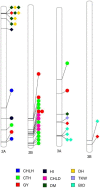Exploiting Wild Emmer Wheat Diversity to Improve Wheat A and B Genomes in Breeding for Heat Stress Adaptation
- PMID: 35937332
- PMCID: PMC9355596
- DOI: 10.3389/fpls.2022.895742
Exploiting Wild Emmer Wheat Diversity to Improve Wheat A and B Genomes in Breeding for Heat Stress Adaptation
Abstract
Wheat is highly sensitive to temperature beyond the optimum. To improve wheat adaptation to heat stress, the best option is to exploit the diversity of wild wheat progenitors. This study aimed to identify germplasm and quantitative trait loci associated with heat stress tolerance from wild emmer wheat diversity. We evaluated a diverse set of multiple derivative lines harboring chromosome segments from nine wild emmer wheat parents under four environments: two optimum environments at Tottori, Japan and Dongola, Sudan, one moderate heat stress environment, and one severe heat stress environment at Wad Medani, Sudan. Genome-wide association analysis was conducted with 13,312 SNP markers. Strong marker-trait associations (MTAs) were identified for chlorophyll content at maturity on chromosomes 1A and 5B: these MTAs explained 28.8 and 26.8% of the variation, respectively. A region on chromosome 3A (473.7-638.4 Mbp) contained MTAs controlling grain yield, under optimum and severe heat stress. Under severe heat stress, regions on chromosomes 3A (590.4-713.3 Mbp) controlled grain yield, biomass, days to maturity and thousand kernel weight, and on 3B (744.0-795.2 Mbp) grain yield and biomass. Heat tolerance efficiency (HTE) was controlled by three MTAs, one each on chromosomes 2A, 2B, and 5A under moderate heat stress and one MTA on chromosome 3A under severe heat stress. Some of the MTAs found here were previously reported, but the new ones originated from the wild emmer wheat genomes. The favorable alleles identified from wild emmer wheat were absent or rare in the elite durum wheat germplasm being bred for heat stress tolerance. This study provides potential genetic materials, alleles, MTAs, and quantitative trait loci for enhancing wheat adaptation to heat stress. The derivative lines studied here could be investigated to enhance other stress tolerance such as drought and salinity.
Keywords: durum wheat; genome-wide association study; heat; multiple-derivative lines; wild emmer wheat.
Copyright © 2022 Balla, Gorafi, Kamal, Abdalla, Tahir and Tsujimoto.
Conflict of interest statement
The authors declare that the research was conducted in the absence of any commercial or financial relationships that could be construed as a potential conflict of interest.
Figures








Similar articles
-
Intraspecific variation for heat stress tolerance in wild emmer-derived durum wheat populations.Front Plant Sci. 2025 Jan 23;16:1523562. doi: 10.3389/fpls.2025.1523562. eCollection 2025. Front Plant Sci. 2025. PMID: 39916777 Free PMC article.
-
Genome-wide association study of multiple traits linked to heat tolerance in emmer-derived hexaploid wheat genotypes.Mol Breed. 2021 Apr 1;41(4):29. doi: 10.1007/s11032-021-01222-3. eCollection 2021 Apr. Mol Breed. 2021. PMID: 37309354 Free PMC article.
-
Harnessing the diversity of wild emmer wheat for genetic improvement of durum wheat.Theor Appl Genet. 2022 May;135(5):1671-1684. doi: 10.1007/s00122-022-04062-7. Epub 2022 Mar 7. Theor Appl Genet. 2022. PMID: 35257197 Free PMC article.
-
Genetic dissection of heat-responsive physiological traits to improve adaptation and increase yield potential in soft winter wheat.BMC Genomics. 2020 Apr 20;21(1):315. doi: 10.1186/s12864-020-6717-7. BMC Genomics. 2020. PMID: 32312234 Free PMC article.
-
Genome-Wide Association Study for Grain Micronutrient Concentrations in Wheat Advanced Lines Derived From Wild Emmer.Front Plant Sci. 2021 May 14;12:651283. doi: 10.3389/fpls.2021.651283. eCollection 2021. Front Plant Sci. 2021. PMID: 34054897 Free PMC article.
Cited by
-
Heat Stress-Tolerant Quantitative Trait Loci Identified Using Backcrossed Recombinant Inbred Lines Derived from Intra-Specifically Diverse Aegilops tauschii Accessions.Plants (Basel). 2024 Jan 24;13(3):347. doi: 10.3390/plants13030347. Plants (Basel). 2024. PMID: 38337879 Free PMC article.
-
Wild emmer wheat, the progenitor of modern bread wheat, exhibits great diversity in the VERNALIZATION1 gene.Front Plant Sci. 2023 Jan 6;13:1106164. doi: 10.3389/fpls.2022.1106164. eCollection 2022. Front Plant Sci. 2023. PMID: 36684759 Free PMC article.
-
Intraspecific variation for heat stress tolerance in wild emmer-derived durum wheat populations.Front Plant Sci. 2025 Jan 23;16:1523562. doi: 10.3389/fpls.2025.1523562. eCollection 2025. Front Plant Sci. 2025. PMID: 39916777 Free PMC article.
References
-
- Aberkane H., Amri A., Belkadi B., Filali-Maltouf A., Kehel Z., Tahir I. S. A., et al. . (2020). Evaluation of durum wheat lines derived from interspecific crosses under drought and heat stress. Crop Sci. 61, 119–136. doi: 10.1002/csc2.20319 - DOI
-
- Aberkane H., Belkadi B., Kehel Z., Filali-Maltouf A., Tahir I. S. A., Meheesi S., et al. . (2021). Assessment of drought and heat tolerance of durum wheat lines derived from interspecific crosses using physiological parameters and stress indices. Agronomy 11, 1–20. doi: 10.3390/agronomy11040695 - DOI
-
- Akter N., Rafiqul Islam M. (2017). Heat stress effects and management in wheat. A review. Agron. Sustain. Dev. 37, 1–17. doi: 10.1007/s13593-017-0443-9 - DOI
LinkOut - more resources
Full Text Sources
Miscellaneous

